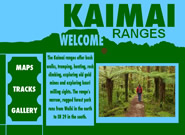Pre-planning

Screenshot from John's project
In 2005, the Katikati/Hillcrest Beacon Practice cluster reviewed its teaching and assessing of Technology in an ICT context, indentifying strategies which could be implemented to address the identified issues.
These included:
- to have one larger project at Year 12 (rather than two as in the past) to allow more time for teaching skills and developing high quality outcomes
- to focus more on technological practice and ICT skill development and less on assessment requirements
- to implement better defined and more easily accessed assessment schedules for the technology achievement standards
- to further individualise teaching, incorporating 'checkpoints' where a student's progress is monitored and moderated
- to make more use of virtual media for documentation
Malcolm worked to build these strategies into the planning of the Year 12 ICT programme where students were challeneged to develop a multimedia solution to an identified issue. Their outcome would be a CD-ROM with some combination of text, images, audio, video, animation and 3D modelling.

Screenshot from Cindy's project
The course was designed to cover a range of multimedia techniques and an introduction to computer programming using ActionScript. Malcolm says that they wanted to add a greater range and depths of skills in the 2006 unit, so planned to include more multimedia skills such as 3-D modelling, and cover digital audio and video in greater depth.
Malcolm incorporated into the unit the alternative ways the cluster had identified of gathering and presenting evidence using the technology available in an IT classroom and developing Alternative Schedules. Instead of using folios to document their work, students would be encouraged to use methods such as screen shots, digital photos, audio clips and digital videos. Along with these, Malcolm would be having several conferences with each student, discussing and questioning them about their practice during the development of their outcome.
Malcolm Howard: "A different approach to assessment meant it was the project driving the practice rather than assessment driving the practice."
Students were given details in a course information handout. This programme structure provided a variety of assessment opportunities with internal and external Technology Achievement Standards being able to be supplemented by an appropriate Computing Unit Standard.
A key change in structure for the year was to delay the focus on assessment until it was necessary. The plan was to turn this around by teaching the aspects of technological practice that the class needed to know, then starting work on projects and finally discussing the specific assessment criteria.